A guest blog by Dr. Frans Kampers, director of the Wageningen biotechnology center for food and health innovation (BioNT) at the Wageningen University and Research Center in the Netherlands.
Using nanotechnology to make food better—it seems like a good idea, but does it have its downsides? Questions over the safety and wisdom of using nanotech in food products and during their production have been bubbling along for some time. Earlier this year, the UK House of Lords launched an inquiry into the use of nanotech in the food sector, while in March the European Food Safety Agency (EFSA) published a scientific opinion on the potential risks arising from nanotechnologies on food and feed safety. And in the past few days, media coverage in Australia has raised questions over the safe use of nanotechnology in food products.
So far the question of safety has been rather confused (especially in the media)—partly because some commentators have been unclear over what types of nanotechnology will potentially be used in food products, and how these specific uses will lead to possible benefits and risks. There’s also been a certain amount of mixing and matching of the data, with data having nothing to do with food being used to raise concerns – not good science!
In March, Dr Frans Kampers, an expert in food and nanotechnology from the University of Wageningen in the Netherlands, gave an excellent overview of why nanotech is of interest in the food sector as part of a symposium at the annual meeting of the American Association for the Advancement of Science. Given some of the confusion in this area, I asked him whether he would mind me posting his notes from the presentation here on 2020science.
He kindly agreed.
Nanotechnology is a rapidly developing innovative technology with applications in very many areas, including food, nutrition and food industry. Many people associate nanotechnology with nanoparticles and link the hazards of nanoparticles to all applications of nanotechnology. However, most nanotechnology does not result in nanoparticles and many nanoparticles are from natural origin and therefore should not be considered nanotechnology. The opportunities of doing business at the nano-level in food applications arise from the realization that foodstuff usually has a structural hierarchy that starts at the molecular and supramolecular level. Creating new functionality in a food product therefore often means starting the modifications at the nano-level…
There are four global challenges regarding food where state-of-the-art technologies like micro- and nanotechnologies can contribute:
- Feeding the increasing world population in a sustainable way;
- Improving the quality and safety of foods;
- Delivering those nutrients to individual consumers that are required for good health; and
- Helping in the prevention of welfare diseases like obesity.
These will be discussed next.
The increasing levels of welfare in large populations will result in shifts in diets towards more protein rich components (meat and fish). Our planet is not big enough to produce the corresponding amounts of meat and/or fish in the traditional way. New technologies will have to be developed to utilize the plant protein sources more efficiently than via animal production. The realization that meat is a material with structural elements also at the nano-level implies that developing a good meat replacement from plant or dairy protein sources requires structuring the product at the nano-level and constructing the structural hierarchy all the way up to the macro-level. Ongoing research at Wageningen UR (Atze Jan van der Goot, Food and Bioprocess Engineering) has delivered first results of such a development.
Creating “artificial meat” by constructing materials with a hierarchical structure, starting from the nanoscale
Although food never was as safe as it is now in industrialized countries, a report from the WHO from 2002 shows that there is still much room for improvement. The food industry is always looking for opportunities to monitor food quality in various stages of the chain more accurately. However, they are handicapped in the sense that measuring microbial activity on a food material requires a well-utilized lab, qualified personnel and time. And time is something that is valuable in chains where quality deterioration occurs rapidly. Food industry would like to have fast, cheap, easy to use, sensitive and accurate devices that can be used close to the production line of foods for the detection of pathogens or the quantification of spoilage organisms. Nanotechnology can contribute to the fulfillment of this demand. The method could be based on the detection of specific DNA fragments developed by Wageningen UR (Aart van Amerongen, AFSG).
Nanotechnologies are also used to improve packaging materials in such a way that the quality of the packaged products is maintained for longer periods in time. Creating better barriers to reduce oxygen leakage in modified atmosphere packaging systems, is a low tech application of nanostructured clay materials. Adding nanoparticles with antimicrobial properties to the packaging material helps to reduce the bacterial pressure inside the package and therefore slows down spoilage. Radio Frequency Identification (RFID) technology in combination with head space sensors can directly communicate information about the real quality status of the product to the logistical systems, the cash desk or even the refrigerator. This will become economically viable in combination with printable electronics, another result of nanotechnologies.
People evolved to thrive on a mix of foods much less calorie-less rich than those found in today’s diet
If everybody eats a varied diet with 200 g of vegetables and two pieces of fruit a day we all would get all the nutrients we need to stay healthy. Unfortunately there are very few people who eat this sensibly. Large groups in society have one-sided diets and run the risk of missing out on certain nutrients. Especially since our food is extremely rich in calories while our digestive system—evolved in times when periods of food scarcity where abundant—is optimized to store as much of the calories as possible. This effect in aggravated because of our life styles that require virtually no exercise to get the food and in which much less energy is required to maintain our body temperature. The result is that we eat much less high calorie food that does not contain very many other components. Our gastro-intestinal tract, designed to process large quantities of low calorie foods, has very little possibility to extract all the necessary nutrients. The food industry therefore develops novel food products that are fortified with specific ingredients.
Nanotechnology-based encapsulation can be used to get essential nutrients into the body efficiently
Nanotechnology can provide microsized containers that can contain various nutrients. The supramolecular structures used for this purpose can mask undesired flavors that would spoil the flavor of the product, can protect the substances from inactivation, can improve the bio-availability of the nutrients and can deliver them to specific parts of the Gastro-Intestinal tract where they are most effective. Creating these structures in a cost effective way is not trivial and requires intricate knowledge of self-assembly mechanisms. At Wageningen UR (Physical and Colloid Chemistry) fundamental research is being done to understand these mechanisms and to find new ways to create these innovative encapsulation systems.
It is well known that welfare diseases like obesity rapidly develop in an epidemic that could threaten the healthcare system in the industrialized world. Apart from the lack of exercise, the main problem is the fact that our food contains too many calories. The intricate understanding of processes at the micro- and nano-level allow us to re-engineer processes in the food industry and to create new products that taste and feel the same, but contain less calories. As an example Wageningen UR research on double emulsions (Food and bioprocess Engineering) was presented where the core of oil droplets of an oil-in-water emulsion is replaced by water. This could result in a mayonnaise that tastes and feels like the full fat kind, but contains much less calories.
Using nanotechnology, emulsions are possible that have the taste and texture of rich foods, but without the calories
At Wageningen UR we are very well aware of the discussions within society about applications of nanotechnologies in food. Societal acceptance is a condition sine qua non to be able to make use of the opportunities discussed above. One of the key aspects of that is the risk/benefit evaluation of these applications. Unfortunately the general public lacks the technical ability and the information to make a good risk assessment, and partly as a result ends up focusing on the hazards alone, rather than a combination of hazard and exposure. Moreover, since the general perception is that “nanotechnology” equals “nanoparticles,” the hazards of “nanoparticles” are equated with risks of “nanotechnology.” But the hazards of nanoparticles concentrate on the non-dissolvable, persistent particles often made of metals or metal oxides. These particles can sometimes traverse barriers, get in the blood stream and enter certain tissue.
The “nano” in many nanotechnology and food applications is in the structure of ingredients and additives, rather than in their overall size
Persistent nanoparticles are rarely used in food products for the very simple reason that the body cannot benefit from them. The nanotechnology in products largely is used to create encapsulation systems that are designed to fall apart in the Gastro-Intestinal tract and release their contents. Afterwards only molecules of food-grade materials remain and no particles are found in the feces of the consumer. Moreover, these encapsulates are usually larger than 100 nm and therefore do not constitute nanoparticles in the usual sense. The nanotechnology is in the wall of these particles to create the specific functionality that offers the new properties to the product.
The full set of slides from Dr. Kampers’ AAAS lecture can be downloaded here. (PDF, 6 MB).

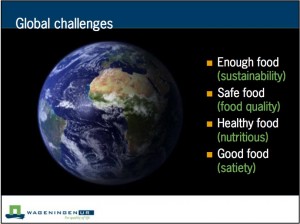
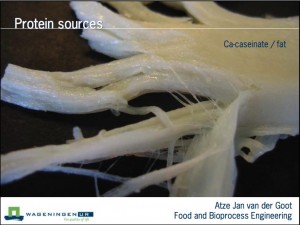
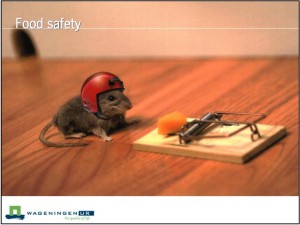
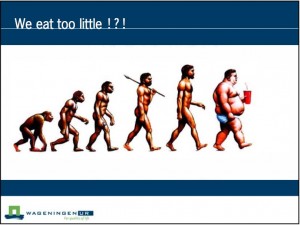
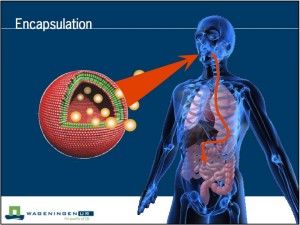
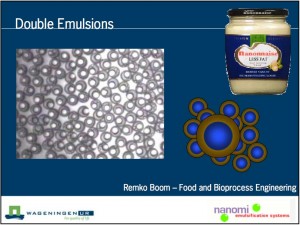
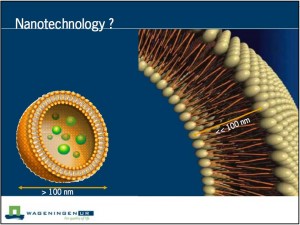
The “Key Words” being ‘rarely used’ and are designed to ‘fall apart’ in the gastro-intestinal tract…would not the bodies defense system attack these foreign particulates my friend or is this all in the name of the great health care investment strategy that we have found Cancer to be a highly lucrative investment? Cheers
Wow, Seanna, you didn’t read that at all did you? The “Key Words” (not sure why you capitalized either of those words) are ‘safe’ and ‘do not constitute nanoparticles in the usual sense’. I’d say that you are a perfect example of this: ‘the general public lacks the technical ability and the information to make a good risk assessment.’
Did a celebrity mention that you should fear nanotechnology? I bet you don’t let your child get vaccinated either. Keep on fear-mongering!
hello
i have a seminar tomorrow. u helped me so much.
thak u